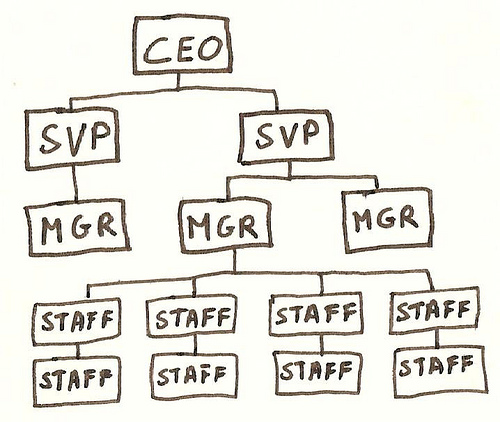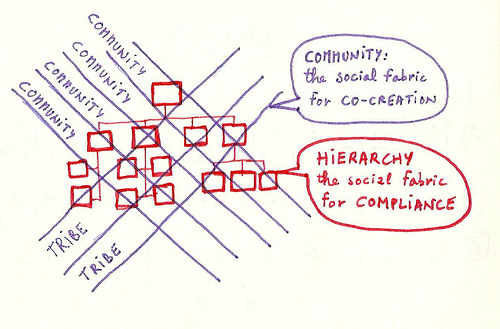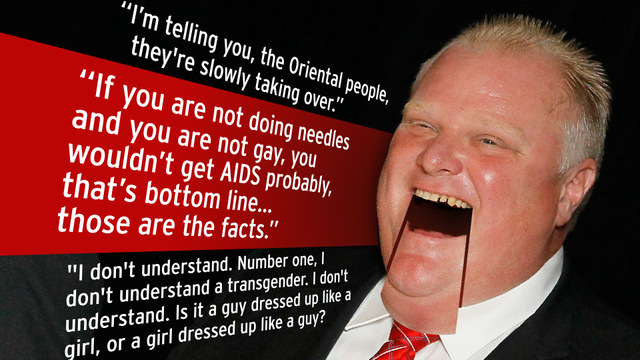Today’s blog post discusses the themes of political correctness and emotional engagement as they relate to organizational design, team management and emerging virtual workplaces.
In his 1979 cover version of a great Nick Lowe tune, Elvis Costello rocketed up the charts singing “what’s so funny ’bout peace, love and understanding?”

If you’re not familiar with the tune, you can check out the music video ….a classic, retro, low budget, low tech offering of the early MTV era.
I am struck by Nick’s question as I listen to my friend talking about preparing for an upcoming “Workplace Violence and Harassment” seminar at work, mandated by Workplace Health & Safety legislation of some sort.
We’ve come a long way in a few years, in music videos for sure, but also in organizational structure, in workplace relationships, and in acceptable norms of workplace behavior.
Today’s blog talks a bit about these changes, about the shift away from political correctness at work, and about an emerging narrative around “emotional engagement” and its use as a management tool in an increasingly social and virtual workplace.
Today, we’re “sharing the love”. And it is not just because we’re heading towards Valentine’s Day!
Political Correctness: A Concept Whose Time Has Come…and Gone?
Political correctness is commonly used to refer to language, ideas, or policies that address perceived or actual discrimination against or alienation of politically, socially or economically disadvantaged groups.
These groups most prominently include those defined by their gender, race, religion, ethnic background, sexual orientation or disability status. In both positive and negative (“politically incorrect”) connotations, these words have always been controversial terms – for the (Russian, early 20th century) communists who first used them, for the (mostly 60s-70s western societies) “liberals” who co-opted them to drive an agenda of social activism and political change, and for the conservatives (everywhere, these days) who oppose PC notions on principle as manifestations of a creeping, overbearing, inteventionist governmental, bureaucratic, and regulatory agenda.

Kate Lorenz has a great list of helpful tips for people to keep in mind who want to “do the right thing” at work. In Being Politically Correct At Work, she notes that “in its best sense, being politically correct means learning about others and respecting the differences that make each of us unique”…and also (she adds) making our own lives richer in the process.
In many ways, this classical (dare we say “liberal”) view of political correctness – with its emphasis on inclusiveness and acceptance – is simply a modern day version of the Golden Rule – the principle of reciprocity that has been known to and practised by major religious groups around the globe for thousands of years. And in this sense, as Danielle Edwards writes, there are huge benefits to the organization from adopting, maintaining and sustaining diversity initiatives.
But the boundaries around political correctness have always been uncomfortably imprecise. In a recent piece entitled Navigating the Quagmire of Humour and Political Correctness, for example, David Granirer weighs in with some PC guidance on workplace humour – jokes about people’s sexuality, minorities, God and grossness in general are “out”. Still safe are jokes about yourself (think your own idiosyncracies), a situation you are all sharing (think reorganization), or personal jokes about areas of “low ego involvement” (a colleague’s shoe choices, as long as they are not a shoe-a-holic presumably) are still “ok”.
Where the boundaries lie may not be exactly clear. What we do know, is that for over 50 years, and for many very good reasons – including the desire to encourage affirmative action, workplace diversity, to pursue workplace equity in all its forms, eliminate discrimination, prevent sexual and other forms of harassment, bullying and abuse — organizations have adopted (voluntarily or through government compulsion) a veritable library of policies, procedures and plans to address all elements of workplace behavior. The pendulum has been in full motion.
The Downside of Political Correctness: From Breaking Bad, to Breaking Worse
Now, though, it seems like the PC pendulum has stalled, and may even be swinging back.
The problem with “PC” – as with any morality based proposition – is the wide variability in opinions that make moving from thought to action so challenging.
Everyone has opinions of course. And all the more so in a world of costless communication, with the free soap boxes and bullyboards of the Internet and social media. Now there is no shortage of ways to share those, whether or not others want to receive them, and whether or not they are based on fact or myth. “Urban myth” has gone global, about political correctness as with anything else.
We see stories about it virtually everywhere. Every day. Public corporations are prodded, and threatened with legislation, to add more women to their senior management teams and boards, because of their gender, despite data that both suggests the root of the problem and the fact that it is well on its way to resolution.
Young artists and female Olympians are castigated for appearing publicly in attire deemed inappropriate in the eyes of self-appointed journalistic gatekeepers and moralists.
Zookeepers are criticised (probably by groups who know considerably less about animals and their treatment) for killing healthy giraffes and feeding them to the lions.
Parents are tsk tsk’d if they choose to raise their children in patterns that don’t conform to the current faddish thinking on what good child rearing is all about. The list is virtually endless. Guidebooks abound.

My friend’s seminar is a good case in point. They have no workplace issues around violence or harassment, as far as they are aware…(and that after due inquiry). The seminar itself is externally, legislatively mandated, by what I will assume can be referred to as the “laboureaucracy” – the laws, regs, bureaucracies, tribunals, lawyers and HR professionals who make it their life’s work to improve our work life.
The seminar represents a sizable investment, by my friend and others in their organization, in cash as well as time. External consultants are engaged. Training materials prepared. Staff asked to drop project work to participate (meaning make-up work is required later). These are, it is true, as my kids say “first world problems“, but they are problems for many nonetheless.
So what will they learn?
They will undoubtedly learn that workplace violence is bad, that conflict should be discouraged, that bullying and harassment on any grounds are unacceptable. They will be provided with information on how to identify inappropriate behavior, and what to do about it when they spot it. They may even discuss workplace stress, anger management, and be provided with tips on what to do when someone “goes postal” at work (likely a non-PC term but so be it).
In short, they will be directed to observe, learn and behave in a particular fashion that has been codified as acceptable by others. They will be spending time “learning” things they likely feel they already know, and/or that they feel reflect common sense, and / or that are largely irrelevant to their day to day workplace experience. Many attendees will likely come away from the session with a diminished sense of themselves and others (the “waste-of-time-why-don’t-they-use-this-money-to-increase-our-comp” reaction).
Such is the state of affairs in the modern organization.
In the eyes of many, based on experiences such as this, the currency of political correctness has been entirely debauched, both at and outside the workplace.
Everyone Loses When Everyone Stops Listening
The response? Rebellion, with apparent widespread popular participation. The silent majority at work. The vast majority of reality TV shows and prime time programming – from Breaking Bad through The Kardashians to Duck Dynasty fit this non PC mould quite nicely. Instead of “turning on and tuning in“, we seem to be ” turning off and tuning out”.
We also see countless other glaring examples of PC “bird flippers” engaging in egregiously politically incorrect behavior, and not only revelling in it but being encouraged in their misbehavior.
Rather than falling on his sword, Rob “yes I did smoke crack” Ford, the Mayor of Toronto, continues to wilfully disregard socially acceptable norms for behavior of public officials, to the consternation of the chattering classes…but apparently with a non-trivial level of public support among those less concerned about political correctness and more concerned about their tax rates, perceptions of elitist (liberal/socialist) bullying, or both. Internationally, as the Winter Olympics start, the Russian government has received condemnation (some argue unfair and hypocritical) over its anti-gay policies, yet they appear to be domestically quite popular.
Political correctness detractors come in all shapes and sizes, as Ford demonstrates. There are many ideologically motivated ranters, who describe the PC movement as destroying America. But there are also lots of more measured perspectives. In a recent blog, for example, Pat Lynch, discusses the perils and pitfalls of PC as the “elephant in the workplace” given its consequences for “filtered communication”.
He is quite clear about the negatives of PC:
- Kill innovation and creativity
- Shortchange employees by masking their actual performance
- Create a toxic environment and a culture of mistrust and fear
- Reward poor performance, causing productivity and morale to plunge
- Foster a culture of mediocrity
And the positives of dialing PC back:
- Performance meets or exceeds clear performance expectations
- Productivity is high as misunderstandings are addressed before they escalate
- There is mutual trust among and between managers and employees
- Poor performers leave because substandard performance is not tolerated
- Constructive confrontation enables constant improvement
In a recent article entitled “Political Correctness Is Killing Our Workplaces” concerns are expressed about the unintended consequences of a power shift between workers that empowers “labellers” while disenfranchising everyone else.
In a provocative piece in Forbes columnist Mike Myatt takes issue with the entire notion that leaders should adhere to a script of politically correct behaviour for moral and ethical reasons, noting leaders are “paid to be correct, not politically correct”. As he comments “politically correct thinking replaces individuality and authentic opinions with socially acceptable rhetoric and watered-down behavioral tendencies….It is this type of issue that pollutes our culture, stifles innovation, undermines our productivity, and sentences those who embrace politically correct thinking to a life of mediocrity.”
Organizational Design In A Post PC World: The New Social Architectures
The funny thing about this debate, though, is how out of touch both sides seem to be with most people and their work experience. Like communism, feminism, separatism and so many other 20th century “isms”. Life has simply moved on. We live in a different world.
No one really carries anymore about “you” from an identity politics point of view any more. And people, particularly younger people, have a deeply embedded sense of acceptance that simply did not exist 50 years ago. Attitudes have changed.
Diversity in the workplace, as in life, is the new normal. The identity politics of yesteryear are being replaced by new workplace environments – old, young, people of every ethnic persuasion. America is unofficially bilingual in certain states, with a huge and growing Spanish speaking population. Blacks and whites rub shoulders with visible minorities from every corner of the globe. Cities like Toronto, New York, San Francisco, Chicago are full of multicultural communities – everyone, all of us, trying to make a living, and getting along reasonably well, all things considered. Misery loves company, the cynics would say.
Like many other 20th century management tools, many of the policies and bureaucracies spawned by the “political correctness” movement have also run their course. They are becoming less and less relevant in our new workday world – a world of fluid organizational boundaries, results oriented work environments, and increasingly diverse, often far flung virtual teams of all races, creeds and colours, coming together to complete tasks and projects. The focus is not on people, but on how they work together effectively to create achievements, and meet or exeed goals, in results oriented workplaces as Cali and Jody describe them. Check them out!
It’s not that the issues have gone away or been solved; people just approach them differently now, and are equipped with an entirely different set of “post PC” tools to deal with them. Naomi Stanford is an amazing and ecletic harvester and sharer of trends and insights on organizational design. I can’t keep up with her!! In a recent Naomi blog I followed her link to Luc Galoppin’s blog on social architecture.
He focuses on the shift from “control” to “co-creation” – the blending of hierarchy and community – as the primary driver of productivity growth and organizational survival moving forward. And this is where (we think) the Organimi organizational design, org chart and photoboard capability intersects.
He comments (sorry for the lengthy quote but it encapsulates the whole thing):
“Our tendency to ignore the invisible parts of an organization chart can lead us to the wrong conclusions about what success really is. What You See When I ask customers to give an overview of the way things are done in their organization, they typically end up showing me their organization chart. Instantly, the most logical question to ask seems to be: ‘Which position is most important in order to get things done over here?‘

There are three types of answers:
- The CEO: those who favor this position as ‘most important’ tell me that this is the person who has the authority to get things done and who carries the vision to inspire the troops;
- The frontline people at the bottom of the organization chart: the argument here is that you can change all you want, but if these people are not committing to your goals you might as well forget it;
- Middle Management: logically, if they are unable to get it all organized, the initiative will fail big time. So there you are: three different answers, all alike in justification.
The truth is that there is no telling which position on an organization chart is most important in order to get things done. That is because the question is a trick question. The real question is: ’Without looking at that chart, what are the ingredients for success?’. The most successful projects in the history of any organization are those where the project manager could gather a team of competent and complementary talents who were working in a relationship of trust. It turns out that the most important part of the organization chart is not the positions (‘the boxes’) or the reporting lines. It is the white space between them.
It is not the number of degrees of a project manager that determines the success of a project. Rather, it is the extent to which this person is able to recruit a network of people from the hierarchy and put them in a social fabric that fosters a community for co-creation. In other words: successful project managers are social architects. They provide a platform on top of the hierarchy, allowing the community of ambassadors to realize the objectives of the project. A Social Architect is someone who makes conscious use of the white space on an organization chart.

In a recent blog post entitled Leadership Is Not A Solitary Task John Coleman also talks about the importance of communities in moving organizations forward, and the importance of leaders working in, with and for their communities.
Communities of “competent and complementary talents working in a relationship of trust” – isn’t that would it should all be about?
Filling The White Spaces and Sharing The Love: Engagement, Community and Emotion

Diversity and employee engagement are clearly connected as the research shows. But we are now moving beyond creating an environment of diversity and acceptance, to one of a deeper level of emotional engagement.
Emotional engagement and the study of emotion and its role in workplaces is now front and center. In a recent blog, Employees Who Feel Love Perform Better, Sigal Barsade and Olivia (Mandy) O’Neill discuss a recent research study on the relationship between compassionate love and performance in the workplace.
As they state “it may not be surprising that those who perceive greater affection and caring from their colleagues perform better, but few managers focus on building an emotional culture. That’s a mistake.”
Instead they noted that “people who worked in a culture where they felt free to express affection, tenderness, caring, and compassion for one another were more satisfied with their jobs, committed to the organization, and accountable for their performance”.
She suggests that leaders do at least three things.
First, broaden your definition of culture. Instead of focusing on “cognitive culture” — values such as teamwork, results-orientation, or innovation — you might think about how you can cultivate and enrich emotional culture as well. Emotional culture can be based on love or other emotions, such as joy or pride.
Second, pay attention to the emotions you’re expressing to employees every day. Your mood creates a cultural blueprint for the group.
Third, consider how your company policies and practices can foster greater affection, caring, compassion, and tenderness among workers.
Most importantly, though, it is the small moments between coworkers — a warm smile, a kind note, a sympathetic ear — day after day, month after month, that help create and maintain a strong culture of companionate love and the employee satisfaction, productivity, and client satisfaction that comes with it.
Meghan Biro echoes this sentiment in her blog Let Love Inspire Your Leadership.
Analogizing the employer-employee relationship, as she does, to dating or marriage likely puts her on dangerous ground for the politically correct. But her message as an affirming one about making work relationships a fulfilling relationship in which both parties thrive in a culture that balances independence with emotional support.
As she notes the payback for organizational commitment to emotional engagement comes in many forms, as reported by organizations with “whole person” employee engagement programs, including lower absenteeism (37%), better safety (48%), higher quality (41%), better customer satisfaction (10%) and improved profitability (22%).
Her advice for organizations is to dump the cynical attitudes about the power of love in the workplace, think about those you love, and bring that same mindset to your employee relationships. This is about caring about them and for them. Helping them build high-quality, fulfilling lives for themselves.
She states:
“This means, first and foremost, making them a partner in their own work lives. Help them develop their strengths. Listen and respond. Give them the tools they need to deliver stellar performance. Then look at ways to integrate their work lives into their whole lives. Childcare, healthy foods, exercise, flexible scheduling. You want to develop a holistic approach, one that views employees as well-rounded individuals, not cogs in a large impersonal wheel.”
In summary, spend more time thinking about how you can “share the love”…with everyone. And don’t feel uncomfortable about it.
After all, as Elvis sings, “what’s so funny ’bout peace, love and understanding?”.

Of course, to get to that stage, you need to know each other, and decide how much you want to share about yourself with each other. That’s where Organimi comes in.
We’re a great tool to help create and build those communities – and to fill the white spaces between the boxes in your org chart with the emotional engagement and energy to get things done and make your workplace a better place for everyone.
Happy Valentine’s Day from all of us on the Organimi team. Share the Love.

